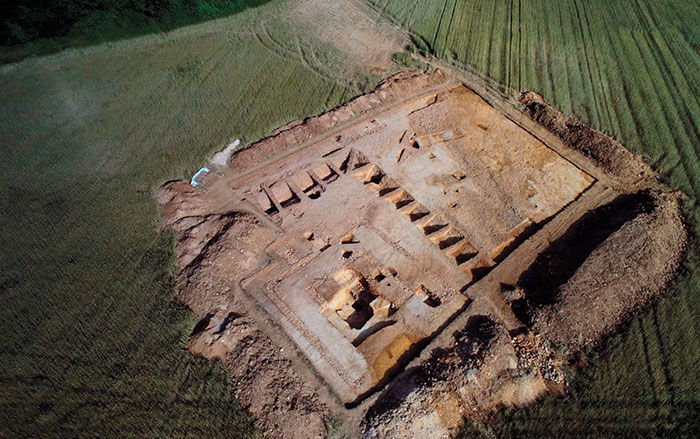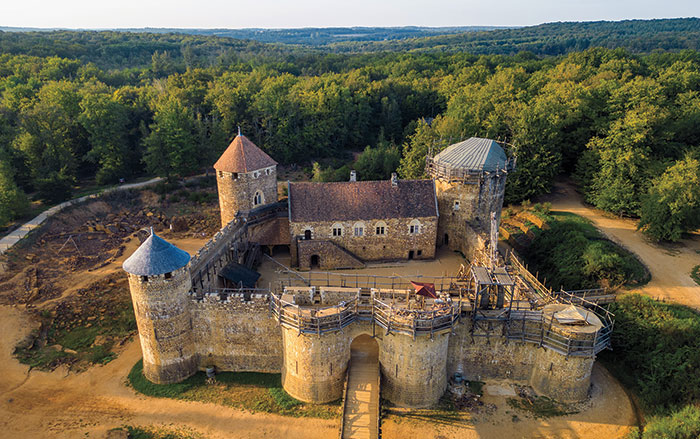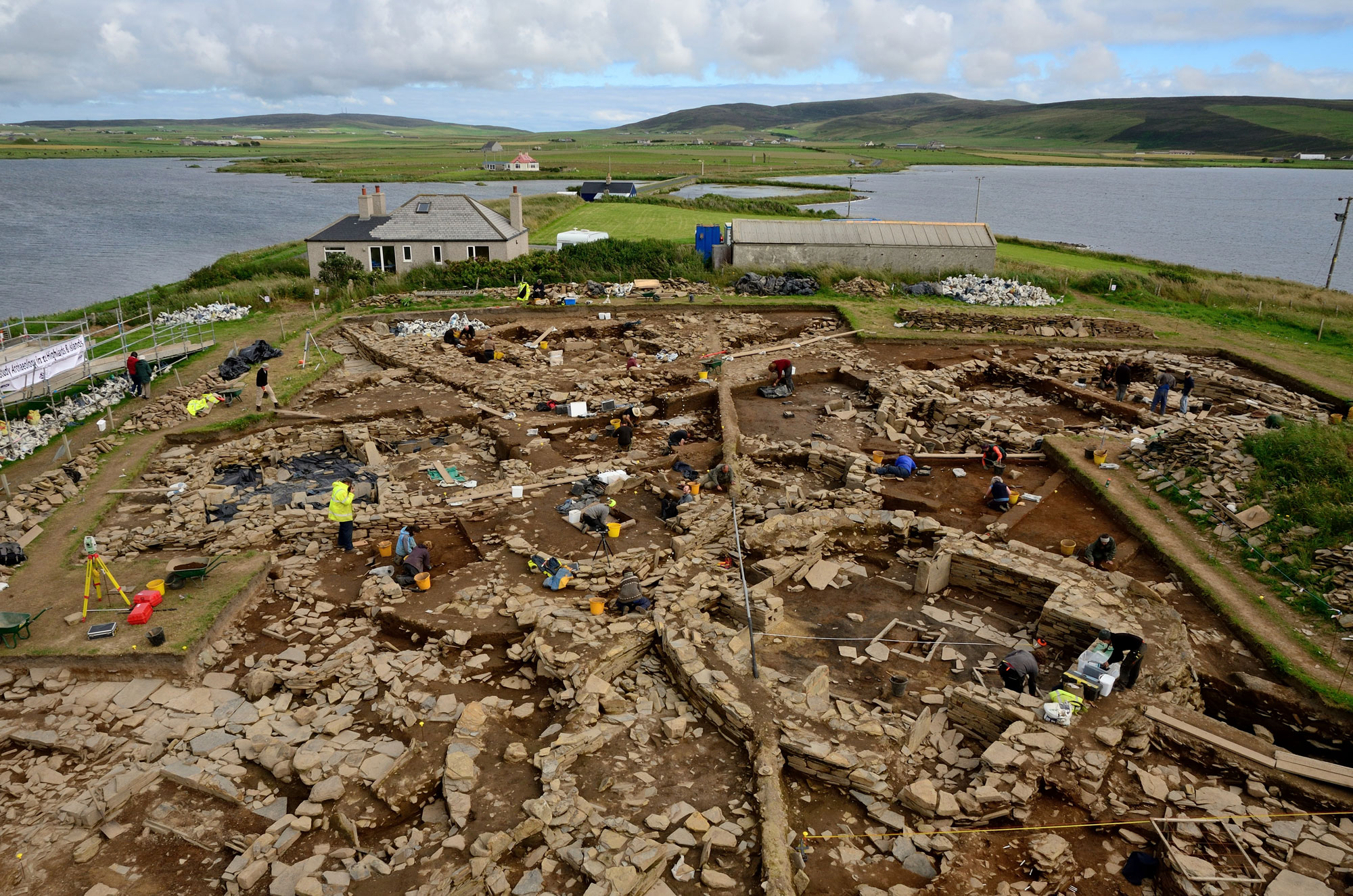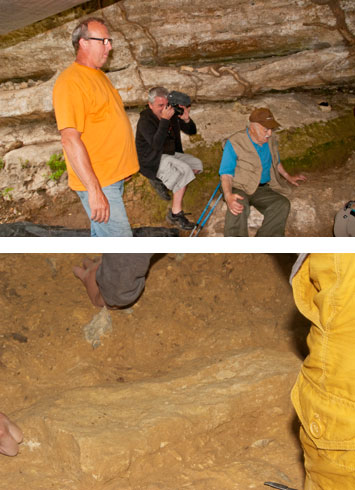
During a car ride through France’s Dordogne department, it doesn’t take long to realize that you’re no longer in wine country. Signs and billboards bearing words like “Cro Magnon” and “Prehistorie” and “Grotte” (French for “cave”) are stationed along the highways and winding roads. Here, the claim to fame isn’t the terroir, but a preponderance of Paleolithic sites, such as Lascaux, Pech Merle, and Font-de-Gaume, all of which hold some of Europe’s earliest cave paintings.
New York University archaeologist Randall White has spent the bulk of the last 18 years here investigating two collapsed rock shelters once inhabited by some of Europe’s first modern humans. Abri Blanchard and its neighbor to the south, Abri Castanet, sit along a cliff face in the Castel Merle Valley, just beyond the quiet, 190-person commune of Sergeac.
Abri Blanchard, perched to the left, and Castanet, to its right, once housed extended families who congregated here in the winter, possibly for the purpose of finding mates, group hunting, and other activities necessary for survival. At Abri Castanet, a steep slope covered by a pile of fallen rocks, soil, and debris extends to the top of the cliff. Immediately to the south is a vast clearing. White says that occupation might have extended south along the cliff face and deep into the clearing. Today, the field is part of Castel Merle, a tourist destination where visitors get the opportunity to practice throwing an ancient spear called an atlatl at a hay bale with a picture of a reindeer on it. White says, “This was Grand Central Station for reasons that are not very clear except for these deep rock shelters.”
A few hours after my first glimpse of the sites this past July, White and 10 members of his team crammed themselves under a tarp overhang in a northern sector of Abri Blanchard. Excavation director Romain Mensan, a geoarchaeologist at the University of Toulouse-Le Mirail, assisted two graduate students in extracting a one-foot limestone slab embedded in the shelter’s floor. The day before, an adjoining piece of this block had been recovered. On its underside was an engraving of what appeared to be the rear of an animal. The team hoped this next piece would provide the rest of the illustration.
“You picked the right time to visit,” team member Amy Clark, a Ph.D. student at the University of Arizona, told me. She was right. After removing the slab from the ground, White’s team determined that the engraving was of an aurochs, an ancestor of modern cattle. White suspects the artwork is about 35,000 years old, though lab results won’t confirm his hunch until early 2013. Nevertheless, the depiction is likely one the earliest pieces of art ever made in Europe.
Archaeologist Randall White (top, in orange) and René Castanet (top right), whose father Marcel was the first person to excavate at Abri Blanchard a century ago, look on as a fragment of the first engraved block (above) found at the site in 100 years is recovered.
Among those there for the discovery was 88-year-old René Castanet, who owns a home a few hundred yards away in the main section of Sergeac. His father, Marcel, was the first man to excavate Abri Blanchard back in 1910. Marcel’s work and the subsequent modern excavations led by White produced evidence suggesting that, almost 40,000 years ago, Abri Blanchard and Abri Castanet played host to families of hunter-gatherers who spent the winter huddled around fires, engaging in the exchange of objects and materials with their neighbors. The wealth of evidence uncovered points to the development of a highly structured domestic space with distinct areas for various activities. Some of those practices, such as the manufacture of ornamental beads worn to signify social standing and the creation of public art, were likely introduced to Europe by modern humans.
“That was the first engraved block to come out of Abri Blanchard since 1911,” White says about the plaque bearing the aurochs. “The fact that René was actually there at a place that 100 years earlier his father had been excavating and finding engraved blocks was a rather moving thing for everybody.”
Forty thousand years ago, Europe was undergoing the so-called Middle Upper Paleolithic transition. As many as 5,000 years earlier, modern humans, or Homo sapiens, began to enter the continent from Africa. Other hominins, specifically Neanderthals, were already in Europe. Over the next 15,000 years, modern humans ventured further west onto the continent. Their encroachment scattered Neanderthals to the Iberian Peninsula in the west and into the Caucasus Mountains in the east. Neanderthals eventually died out roughly 30,000 years ago.
There is no archaeological evidence pointing to any Neanderthal occupation in the rock shelters of Castel Merle Valley. Additionally, White and his colleagues hypothesize that there might have been only a relatively short window of time between formation of the rock shelters from climatic and geologic processes and their collapse.
White believes the area was a wide-open steppe with about 10 percent forest cover. The Vézère River is less than 200 yards away from the rock shelters and a freshwater spring still flows just in front of them. The average temperature in the region would have been anywhere from five to 20 degrees cooler than the roughly 50 degrees Fahrenheit it is today.
The hunter-gatherers who assembled at Abri Castanet and Abri Blanchard would have primarily eaten reindeer, the bones of which make up more than 90 percent of the animal remains found. White speculates they would have been hunted one at a time. The rock shelters were likely one of many sites occupied during what White calls the typical hunter-gatherer pattern of aggregation and dispersal. “We’re a little perplexed about why all these symbolic activities are here,” White explains. “It’s a rather inhospitable place to live.” He notes that Castel Merle would have had cold air currents, causing it to be a few degrees cooler than the rest of the Vézère River valley.
The preponderance of reindeer near the Vézère might have lured early Aurignacian people during the winter because the animals’ hides would have made ideal coverings and clothing. Summer occupation sites may have been as far flung as Brassempouy, 150 miles southwest, near France’s Atlantic coast. That site, famous for its Venus, the head of an ivory figurine dating back 25,000 years, includes some of the same ornamentation found at the Castel Merle sites. Faunal remains at Brassempouy are of reindeer, as well as horses and bovids, such as sheep, goats, and wild oxen.
“We don’t have these people’s seasonal trajectory figured out,” says White, noting that the evidence of bead production seen at Abri Blanchard and Abri Castanet far outstrips that seen at other contemporary sites, like Brassempouy. Much of the material used to make beads and other ornamentation comes from far away. Soapstone from the central Pyrenees Mountains and seashells from both the Atlantic Ocean and the Mediterranean Sea have been found at Castel Merle. There’s no evidence that mammoths roamed southwestern France, so ivory could have come from southern Germany.
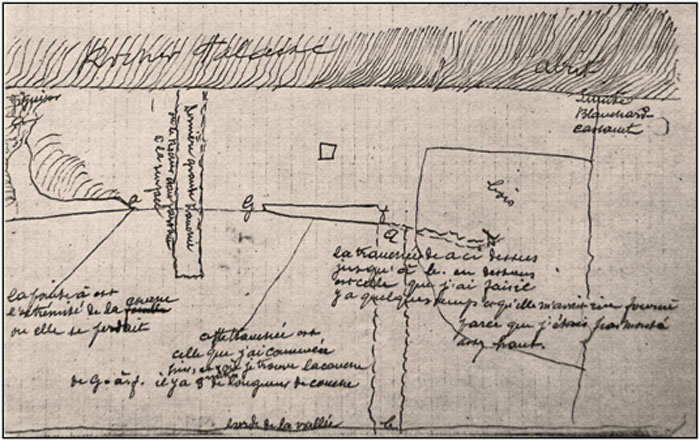
According to White, it was Marcel Castanet’s discovery of an ivory bead in a foxhole at Abri Blanchard that prompted the first excavation of this particular cliff face, back in 1909. Castanet owned a farm overlooking the cliff, where the Auberge de Castel Merle hotel now stands. He contacted Louis Didon, an amateur archaeologist and hotel owner who lived in Périgueux, 30 miles away, to take out a lease on the site. By June of 1910, Castanet was digging on Didon’s behalf.
As Castanet dug, he wrote reports on what he’d found, which he would send in letters to Didon every three or four days. “It’s actually a testimony to the efficiency of the French mail service— even back then, letters got to their destination in a day,” says White. He has relied heavily on the archive of letters to guide his own work. Didon could react relatively quickly with new dig directives. “Castanet writes these reports and he includes in them wonderful little drawings and describes where he’s excavating,” White continues. “We have a really quite remarkable record that was never intended to be a field record.”
A couple of months into the excavation, Castanet wrote to Didon and described a large limestone block with a heart-shaped engraving. Didon sent a sketch of the depiction to Abbé Henri Breuil, a Catholic priest and amateur archaeologist, who interpreted it as a vulva. Breuil’s interpretation persists today, and the shape is found frequently at Aurignacian sites (See “Top 10 Discoveries of 2012”).
Castanet also told Didon about an adjacent site to the south with artifacts likely from the same period. Didon passed on leasing that site, but Denis Peyrony, a schoolteacher in the commune of Les Eyzies-de-Tayac-Sireuil, who would excavate 20 sites in the region, bit. So, as Castanet wrapped up his work at Abri Blanchard at the end of 1911, he began digging at the site that would bear his name, Abri Castanet.
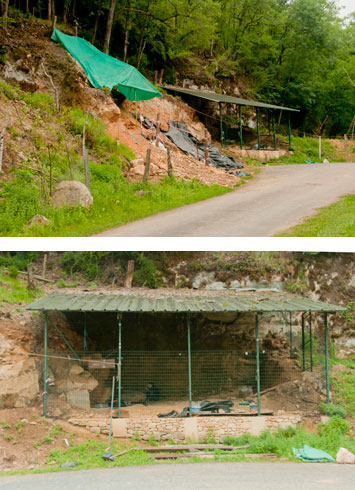
Peyrony once wrote that Abri Castanet was the most dangerous site he had ever been associated with. A vertical channel at the top of the cliff face had allowed a flow of rocks and debris from above to loosely cover the archaeological layers and collapsed roof at Abri Castanet. At the middle of Abri Castanet, there remained 40 feet of rubble to get through to expose the surface that the Aurignacian people lived on. Thus, Peyrony’s digs focused on a relatively accessible area at the northern end of the site. Later, in 1995, when White began digging at the southern end, he had to bring in power shovels to remove the stones and dirt and expose the artifact-bearing surface.
White excavated the 300-square-foot “Castanet South,” as he calls it, until 2010, recovering 150,000 artifacts—from limestone blocks to burnt antler bones to tiny ornamental beads. His team is meticulous, excavating in two-and-a-half-square-foot blocks and retaining every particle down to 0.05 inches in size. During my visit to the site, several crew members mentioned White’s attention to detail. And Jean Clottes, an archaeologist who once served as director of prehistoric antiquities for the Midi-Pyrénées region of France, praises White’s fastidious approach. “What is special about Abri Castanet is Randy White took it up with modern methods. That was not done in other shelters of the same period,” he says. “He’s got far more reliable results and far more precise results.”
By carefully studying the microstratigraphy and composition of the limestone of the collapsed roof, White’s team estimates that Abri Castanet was about six-and-a-half feet high, 100-feet wide, and about 20 feet deep, with a ceiling reachable by Aurignacians standing on tiptoes, allowing them to modify it. Several blocks found at Abri Castanet during Peyrony’s excavations, as well as White’s, bear deep gouges in them that formed raised ring shapes known as anneaux. According to White, the anneaux appear both on blocks that would have been on the floor of the shelter and on parts of the collapsed roof. So far a total of 30 of them have been found on 18 different slabs. The working hypothesis is that they were used to string up reindeer hides, so that the Aurignacian people could close off the front of the shelters and effectively heat the space.
There were four fire features uncovered in Abri Castanet’s southern sector. Using magnetic susceptibility, which identifies iron-rich patches of soil that are indicative of burning, the team was able to identify a central fire pit, roughly one foot in diameter and one foot deep, dug directly into the bedrock. It appeared to have been renovated continuously for multiple uses.

White notes there are distinct areas where certain types of artifacts are found, and specific activities were carried out around the central fire pit. To the northwest, toward the front of Castanet South, is an eight-square-foot section where 80 percent of the debris from the manufacturing of ornamental ivory beads was found. “This is prime bead-making area,” he says.“I first came here because these sites had yielded so many beads.”
Claire Heckel, a Ph.D. candidate in archaeology at New York University, describes the beads, hundreds of which have been recovered, as “basket-shaped,” rounded at the base with a little handle. They measure a quarter of an inch on average and were likely sewn onto garments with horse hair or another plant or animal fiber. “What was probably driving the advent of this behavior were distant social networks coming together that required signaling your identity to people who may not know your status,” Heckel explains.
One of the fire features is full of burnt antler bone that White believes was probably shaped into points with split bases for hand-thrown spear tips—the hunting weapon that predated the atlatl. Elsewhere, there are waste flint flakes that suggest it may have been a spot where stone tools were sharpened. Twenty percent of the tools at the site are made of flint from Bergerac, a commune roughly 40 miles west of Castel Merle, indicating that Aurignacians likely came here by way of Bergerac. Romain Mensan says the tool kit found at Castanet South includes end scrapers, keeled scrapers, and large blades with fish-scale patterns that could be up to nearly a foot in length.
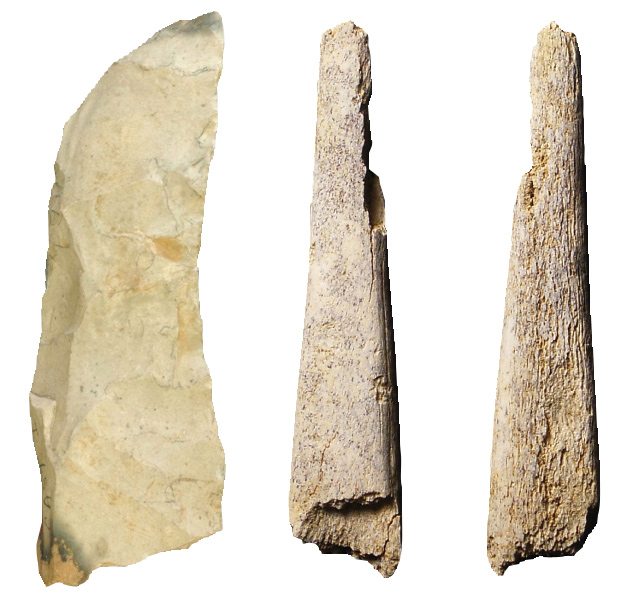
There’s no evidence, however, of the production of blades, though Peyrony’s excavation notes include the discovery of many flint cores from which blades had likely been struck. White explains that this is further evidence of the organized distribution of disparate activities taking place throughout the site.
Special zones at Abri Castanet and Abri Blanchard were not restricted to the practice of various industries. Art also tended to appear primarily in specific sectors of the sites. Both Marcel Castanet’s and White’s excavations have yielded several blocks with geometric engravings and a few paintings, done with black manganese and red ochre, of animals, such as bison.
Some of the art is found on slabs that were part of the ceilings of both shelters, but much appears on freestanding plaques, including the engraved aurochs found this summer at Abri Blanchard. The plaques were found with their engraved surfaces facing down, but because their illustrations follow the edges of those blocks, White says, the stones were unlikely once part of the roof. He adds that, according to Marcel Castanet’s notes on his excavations at Abri Castanet, several other engraved and painted blocks were found with their decorated surfaces turned toward the ground.
“One working hypothesis is that there is, for lack of a better word, ritual deposition of these things,” says White. He notes that three-quarters of the engraved blocks were at the northern end of Abri Blanchard. “What it confirms is that these places where there are engravings are perhaps special places within the site. There may be concentrations of them,” he continues. “I think that’s raw material for thinking about the context in which art is being done and seen.”

Over his 18 years of work, White has uncovered a lot of raw material for thinking about the daily life of the earliest modern humans in Europe. When he started digging at Abri Castanet, White says, no one knew for certain what timeframe within the Aurignacian they were dealing with. Colleagues assumed, for instance, that body ornamentation would have been a behavior that later Aurignacians might have engaged in. But White’s evidence clearly shows that some of the first modern humans in Europe were making beads.
The resolution on the picture becomes sharper when you add in Abri Blanchard. “Until about four years ago, we didn’t even know where Abri Blanchard was,” White says. “This whole hillside was completely wooded.” According to White, Blanchard is the richest Aurignacian site ever excavated in Europe, yielding hundreds of split-based points, bone and antler pieces, hundreds of beads, and all the production stages for their manufacture.
“Our work provides really precious insights into group organization and the very highly structured nature of domestic space in the early Aurignacian,” says White. “Not to bash Neanderthals, Neanderthals are great. I think they just weren’t operating in the same way.”



